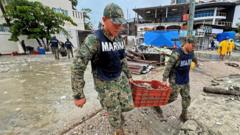Southern Mexico commenced a significant clean-up operation on Thursday following Hurricane Erick’s powerful landfall as a Category 3 storm along its Pacific coast. The tourist town of Puerto Escondido in Oaxaca experienced extensive damage, including loss of electricity, disrupted phone services, and flooding that affected key infrastructures, such as two hospitals. Fortunately, no casualties or injuries have been reported.
After making landfall and quickly diminishing to a Category 1 storm, the National Hurricane Center (NHC) warned of residual flooding risks and hurricane-force winds as Erick advanced northward. Following the storm's passage, potential dangers remain, including life-threatening storm surges and waves reaching heights of up to 10 meters (33 feet).
In response to the devastation, hundreds of military personnel have been deployed to assist with clean-up efforts in Puerto Escondido, where many roads were rendered impassable by flooding. Local merchant Luis Alberto Gil described the unprecedented impact of the water on the town, stating, "The water had never hit with this magnitude."
State-owned utility CFE reported that over 120,000 users were left without power in Oaxaca, with service restored to a quarter by late morning. Shortly before losing intensity, gusts in the area clocked in at 125 mph (205 km/h), tapering down to 85 mph as the storm progressed.
Approximately 250 miles (400 km) further north, in the resort city of Acapulco, residents adhered to safety guidelines by hunkering down, causing the area to appear largely deserted, with shops boarded up and tourist boats grounded. Many residents had prepared in advance, stocking up on essentials.
Alerts for life-threatening flash flooding and mudslides remain in effect across Oaxaca and neighboring Guerrero as storm conditions persist. The NHC noted Erick's rapid weakening and probable dissipation later on Thursday.
In light of the storm, President Claudia Sheinbaum advised residents to remain indoors and urged those living in vulnerable areas or near rivers to evacuate to shelters, with around 2,000 shelters established in Chiapas, Guerrero, and Oaxaca ahead of the storm's arrival.
The catastrophic aftermath of Hurricane Otis earlier this year, which resulted in at least 50 fatalities in Acapulco, underscores the region's vulnerability to extreme weather events, prompting citizens and officials to remain alert in the face of natural disasters.






















